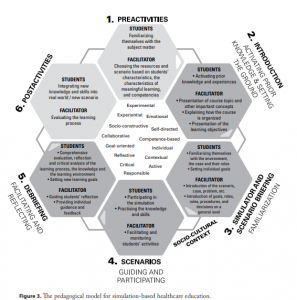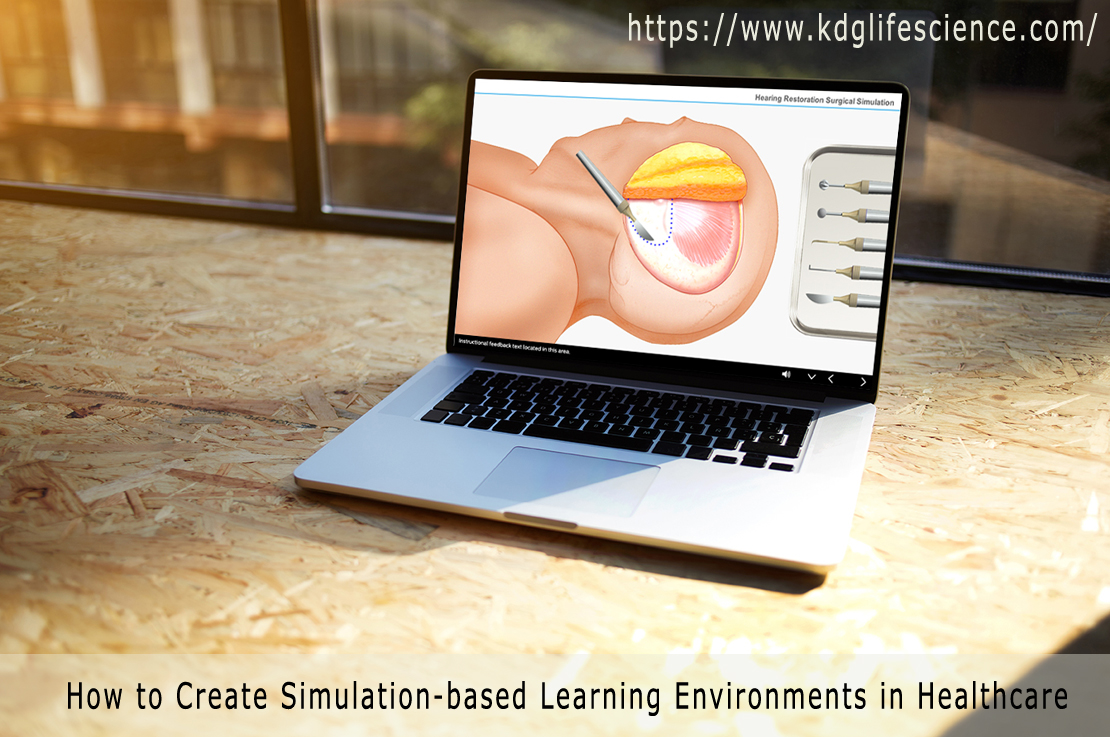The use of virtual reality (VR) and simulation has earned a central place in modern training and learning environments, including in aviation and aerospace, space exploration and military applications. However, nowhere has its application become more pervasive than in simulation-based learning environments (SBLEs) in healthcare. The rapid pace of development in medicine makes it even more essential for healthcare course designers to use simulation as part of their instructional design approach.
Instructional design approaches and strategies
Thankfully, there are several instructional design (ID) approaches that one can leverage when developing healthcare instructional content. Traditional ID models, such as ADDIE and ASSURE might still be leveraged in some healthcare learning environments. However, using these strategies in a healthcare setting in concert with experiential learning approaches, such as simulation, can produce better learning outcomes. In fact, the online journal Simulation in Healthcare suggests : that simulation is effective for teaching critical care medicine to medical students, yielding large favorable benefits over other teaching methods despite relatively short simulation sessions.
The measure of success that instructional designers will achieve in applying these strategies will depend on the audience (learners), the product/procedure being trained, or the software, tool, device, equipment or healthcare environment that is being simulated.
Tuulikki Keskitalo, a Doctor of Education, part-time Principal Lecturer at the Lapland University of Applied Sciences (Rovaniemi, Finland) and visiting scholar at Stanford University, School of Medicine (Palo Alto, CA, USA), has extensively studied and written about the pedagogical model for virtual and SBLEs in healthcare.
In one of her papers, titled Developing a Pedagogical Model for Simulation-based Healthcare Education, Dr. Keskitalo proposes the following pedagogical model:

Instructional designers should keep in mind that Dr. Keskitalo’s model for simulation training builds on previously developed models which suggest the ideal design of simulation training in a 4-phased structure:
- Introduction
- Simulator briefing
- Scenarios
- Debriefing
By combining this structure with some key considerations of the course, that must include Interactivity, Participation, Uncertainty and Variations, and you can put together powerful and highly-effective simulation training content.
Benefits for healthcare
Simulated healthcare training is one of the biggest beneficiaries of “learning by doing”, an inductive learning approach first introduced by American philosopher John Dewey. Other thinkers coined the phrase “experienced-based learning” to define the essential characteristics of trial-and-error learning espoused by simulation training approaches.
Here’s how the use of SBLEs can benefit healthcare instructors and learners:
- The environments, such as ERs, Operating Rooms, Primary and Palliative Care units, in which practitioners (Nurses, Physicians, Surgeons) deliver their services are highly specialized. Text, video and animated learning content isn’t suitable to replicate the nuances of such practicing environments
- High-quality healthcare depends on the use of expensive devices and tools, such as magnetic resonance imaging (MRIs), X-Ray and CT scanning equipment. Most healthcare training environments typically can’t afford to acquire or lease/rent these devices. Simulated training offers a cost-effective alternative
- Even where lease/rental costs aren’t a barrier for healthcare training institutions, the limited number of such devices, environments and facilities around the country makes access a challenge for trainers. Using SBLEs can be a more readily available option
- Though the underlying approach to delivering healthcare, such as diagnosis by using MRIs or CT scanners, might not change dramatically, some use-cases may change as a result of advances in medical science theory. Simulated healthcare training content can more readily be adapted to include such breakthroughs
- Ideally, healthcare is best learned when practiced on “live” patients. However, this is not a practical approach where “learn from your mistakes” or “to err is human” is not an option. When it comes to hands-on practice of invasive procedures, simulated training is a close replacement to “the real thing”. The benefit of a SBLE is that learners can hone their skills and perfect their techniques through repeated practice, without putting human lives in danger or distressing already stressed patients
Unlike many of the arts and sciences (Literature, Economics, Creative Writing or Biology), healthcare is an extremely complex topic for instructional designers to address. As a result, while course designers can typically meet instructional design objectives for the former disciplines through more traditional approaches – text, graphics, animation, video and audio – there are many more advantages to using simulation (rather than more traditional approaches) to teach healthcare topics.
Simulations that teach how to use devices
As suggested earlier, some medical devices are beyond the financial reach of most healthcare training environments. In other instances, these devices are in such high demand (for clinical and training applications), that availability becomes a huge issue for novice healthcare professionals.
A physical procedures simulator, (also called an object-based simulator) that look and feel like the real environment, is an alternate way to address both the above challenges. This type of simulated teaching might involve the creation of an alternate environment, using an equipment, device or machine, which mimics the functionality of the actual device.
Instructional designers can leverage such simulators to train learners on performing certain medical procedures, such as the use of MRI equipment in radiation therapy (RT), or the training modules might focus on developing skills on how to operate or use the actual device itself.
Software simulations
More and more, healthcare training professionals rely on software-based teaching tools to impart clinical skills to learners. From monitoring a patient’s vital signs during performance of complex surgery, to delivering post-surgical healthcare, all these clinical interactions increasingly rely upon software-based tools.
Software simulator-based (also called software emulation) instructional content replicates the features and functionality of the clinical software that learners are being trained for. Typically, the modules created will replicate real (based on actual clinical experiences) or hypothetical situations, and allow repeated performance of the procedure in different clinical settings.
Alternately, instructional designers might use operational simulation training, which may be a combination of object-based and software-based training tools. Content can be produced which simulates the performing of common clinical procedures using specialized equipment and best practices to deliver the most favorable patient outcomes.
Features of good simulation training
Before using simulation training techniques, it is essential to understand the salient features that good simulated training should contain. Some of these elements include:
- Integrating simulation as part of the overall curriculum
- Mandate repeated use of a simulated content – even if the learner has aced the module on his/her first attempt
- Make sure the simulated content includes graduated (in smaller or greater increments) levels of complexity
- Provide for clinical variations in the simulated content
- Offer plenty of feedback – both correct (reinforcement) and incorrect (corrective)
- Always control the environment in which simulation occurs. Uncontrolled simulation can breed unhealthy clinical practices
Finally, when designing your training content, allow for both team-based as well as individualized simulated learning. While some procedures, like intubation, routine dental hygiene cleaning, or changing a dressing might best be suited for individual learning. More complex procedures, such as assisting in a busy OR and fostering collaboration between radiographers and radiation therapists, make for good team-based simulation.
As the Liverpool Cancer Therapy Centre did in June 2013, when they installed Australia’s first dedicated MRI simulator, instructional designers will need to work with cross‐disciplinary teams of radiographers and radiation therapists to develop simulator-specific training protocols.
Software simulations
Boston Scientific’s WATCHMAN® is a permanent implant for patients with atrial fibrillation (AF) – a condition that can lead to heart-related complications such as blood clots, stroke or heart failure. The Atritech WATCHMAN® Simulation program is a great example of software simulation training to help healthcare practitioners make the best use of the WATCHMAN® implant.
Developed by KDG, this program used 3-D images of data from patients with AF who have had the device implanted in their left atrial appendage (LAA). By providing physicians and sales representatives a real-time view of the data, controlled on a game pad controller, KDG’s software simulator helps users understand how to correctly implant the device. Most importantly, the program provides generous amounts of feedback to its users, both correct and incorrect.


Very interesting and informative-Thank you